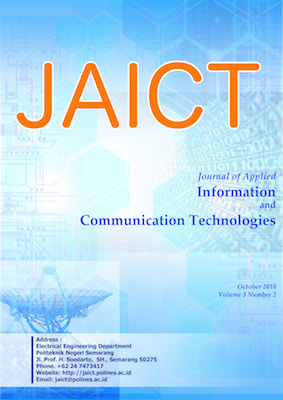Batik Originality Marker As a Protection Model To The Manufacturer And Batik's Consumer
DOI:
https://doi.org/10.32497/jaict.v3i2.1336Keywords:
Batik, consumer, manufacturer/seller, protectionAbstract
Such way from Pekalongan City Government in protecting the existence of crafstmen/batik seller and its consumer is by publishing region regulation of Pekalongan City Number 6 in year 2014. By that regulation, Pekalongan city government obligue all manufacturer/batik seller that produce and sell batik product in/from Pekalongan city should label their product with “ Batik Pekalongan”, hence it is not only functioned as a marker for consumer that is not able to identify the kinds of batik nor differentiate with printing batik, but also functioned as a protection model for the manufacturer/batik seller in Pekalongan. Nevertheless the absence of monitoring in the usage of label “Batik Pekalongan”, has been absorbed by certain manufacturer/batik seller to make fraud, thus the effort of Pekalongan city governmnt in giving protection to the manufacturer/batik seller and also their consumer hasn”™t been well realized. The research resulted an e-label batik application that supports the effort of Pekalongan city government, by augmented reality technology utilization will make the label of “Batik Pekalongan” displaying such information about the kinds of batik, batik pattern/motif, the profile of the manufacturer/batik seller and other related information, if consumer scans that label by their smartphone, the information will be just displayed, and when the Pekalongan city government as the observer of the usage of batik label has done the validation based on the sustainability of the label certainty with the kinds of batik sold by the manufacturer/seller, the label of “Batik Pekalongan” will be functioned as the trusted markReferences
Rindia Fanny Kusumaningtyas, "Perlindungan Hak Cipta Atas Motif Batik," Jurnal Pandecta (Jurnal Penelitian Tentang Hukum) Vol. 6 No. 2, pp. 1-10, 2011.
Muhammad Rifa'i, Tri Listyorini, and Anastasya Latubessy, "Penerapan Teknologi Augmented Reality pada Aplikasi Katalog Rumah Berbasis Android," Prosiding SNATIF Ke-1, pp. 1-8, 2014.
Febrian Wahyutama, Febriliyan Samopa, and Hatma Suryotrisongko, "Penggunaan Teknologi Augmented Reality Berbasis Barcode sebagai Sarana Penyampaian Informasi Spesifikasi dan Harga Barang yang Interaktif Berbasis Android, Studi Kasus pada Toko Elektronik ABC Surabaya," JURNAL TEKNIK POMITS Vol. 2, No. 3, pp. 1-6, 2013.
D. Han, T. Jung, and A. Gibson, "Dublin AR: Implementing Augmented Reality (AR) in Tourism," Information and Communication Technologies in Tourism, Springer International Publishing, pp. 1-13, 2014.
Pemerintah Kota Pekalongan, Peraturan Daerah Nomor 6 Tahun 2014. Kota Pekalongan, Indonesia: Pemerintah Kota Pekalongan, 2014.
Meika Hapsari, Perlindungan Konsumen Melalui Implementasi Pasal 3 Jo Pasal 6 Perda Nomor 6 Tahun 2014 Kota Pekalongan Tentang Penggunaan Label Batik Pekalongan. Skripsi. Semarang: Fakultas Ilmu Huku Universitas Negeri Semarang, 2015.
Agus Sardjono, Brian Amy Prastyo, and Desrezka Gunti Larasati, "Pelaksanaan Perlindungan Hukum Merek Untuk Pengusaha UKM Batik di Pekalongan, Solo dan Yogyakarta," Jurnal Hukum dan Pembangunan Tahun ke-44 No. 4 Oktober - Desember , pp. 1 - 22, 2013.
Anis Sujana, Suharno, and Ari Winarno, "Konservasi Seni Batik Berbasis Multimedia: Konsep dan Eksekusinya," Prosiding Penelitian dan Pengabdian Kepada Masyarakat (PKM), Sekolah Tinggi Seni Indonesia (STSI) Bandung, pp. 15-22, 2013.
Uning Lestari and Annafi”™ Franz, "Aplikasi Augmented Reality untuk Pengenalan Pola Gambar Satwa Menggunakan Vuforia," Jurnal Generic, Vol. 10, No. 1, pp. 1-9, 2015.
Dhanar Intan Surya Saputra, Ema Utami, and Andi Sunyoto, "Penerapan Mobile Augmendted Reality Berbasis Cloud Computing Pada Harian Umum Radar Banyumas," Seminar Nasional Informatika 2013, 2013.
Downloads
Published
Issue
Section
License
Authors who publish with this journal agree to the following terms:Authors retain copyright and grant the journal right of first publication with the work simultaneously licensed under a Creative Commons Attribution License that allows others to share the work with an acknowledgement of the work's authorship and initial publication in this journal.
Authors are able to enter into separate, additional contractual arrangements for the non-exclusive distribution of the journal's published version of the work (e.g., post it to an institutional repository or publish it in a book), with an acknowledgement of its initial publication in this journal.
Authors are permitted and encouraged to post their work online (e.g., in institutional repositories or on their website) prior to and during the submission process, as it can lead to productive exchanges, as well as earlier and greater citation of published work (See The Effect of Open Access).






